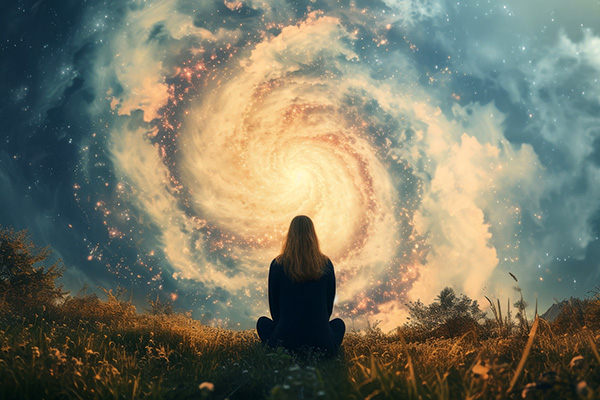higher power
Rediscovering Prayer As A Personal Practice
 “Prayer” can be a complicated concept for some people, especially when it carries associations with dogma or specific religious traditions.
“Prayer” can be a complicated concept for some people, especially when it carries associations with dogma or specific religious traditions.
On a spiritual path, not everyone relates to a higher power in the same way, and we all experience the sacred or the divine through diverse and deeply personal lenses.
However, no matter how we personally view it, prayer can hold a very meaningful place in any spiritual practice.
As my own spiritual awareness deepened, I came to see God not as a distant figure watching over the world, but as a vast creative presence, an energy that flows through all life. Some connect with this presence as “the universe,” others as their higher self, their guides, or a field of eternal love and light.
I have moved through many of these perspectives myself, and each has offered me unique insights. Over time, returning to the broader concept of God reopened a space of comfort and peace within me, especially through the practice of prayer.
When I was a child, prayer felt natural. It brought reassurance and warmth. Reconnecting with it later in life has brought that same sense of grounding and clarity.
Prayer can be understood as a conversation with God, Source, Spirit, the Divine, with one’s soul, or with the deeper wisdom that resides within and around us. Continue reading
Holding On To What Never Changes
 Nature always inspires deep thoughts in me. There’s something about pausing to watch the wind rustle through the trees or to see the sun gently filter through the clouds that invites stillness and reflection.
Nature always inspires deep thoughts in me. There’s something about pausing to watch the wind rustle through the trees or to see the sun gently filter through the clouds that invites stillness and reflection.
Today, I found myself contemplating the constantly changing seasons. In the Northern Hemisphere, we are a month away from the summer solstice, and the days are becoming increasingly long and warm with golden light. The trees are lush and full, the air hums with the sound of insects, and gardens overflow with life.
Change is everywhere. It’s evident in the ripening of fruit, the intense afternoon heat, and the subtle shift in the season’s energy toward harvest.
It’s not just nature, either. Our lives are constantly evolving, too. Relationships shift, careers transition, health fluctuates, and dreams reshape themselves over time.
No matter where we turn, we hear messages such as “Change is inevitable,” and “Don’t be afraid of change.”
Yes, change is necessary. As spiritual beings, we are meant to continually grow and evolve. Change challenges us, stretches us, and teaches us.
But let’s be honest — sometimes it’s also deeply unsettling. This is especially true in times like these, when the world feels uncertain, divided, and fragile.
Realigning With Your Higher Self
 In my readings, I often feel that people’s energy is fragmented — like an incomplete jigsaw puzzle with missing pieces. This fragmentation reflects a general disconnection from the core essence of their being: the higher self.
In my readings, I often feel that people’s energy is fragmented — like an incomplete jigsaw puzzle with missing pieces. This fragmentation reflects a general disconnection from the core essence of their being: the higher self.
It’s no surprise that modern life pulls us in countless directions, leaving us feeling stretched, overwhelmed, and out of balance. Between the demands of work, family, and personal goals, the balance of work, rest, play, sleep, and spirit seems to have slipped through our fingers.
Compounding this imbalance is our growing impatience and intolerance. We bristle at delays, resist restrictions, and struggle when life deviates from our carefully laid plans.
Yet frustration and impatience only hinder the natural unfolding of our highest good. The person we are waiting to meet or the opportunity we are longing for may not be ready to enter our lives — or, more likely, we may not be ready to welcome it.
When we feel lost, stuck, confused, or fearful, these are signs of misalignment or disconnection from our higher self. This distortion cuts us off from clear inner guidance and spiritual awareness, leaving us adrift in a sea of doubt, fear, and negativity.
Realigning with our higher essence restores the natural flow of energy, inner wisdom, and divine guidance. We rediscover our wise inner genius, the calm confidence that resides within, and the power to live in harmony with our true essence and fulfill our soul plan.
How To ‘Face Everything And Rise’ (F.E.A.R.)
 It’s okay to feel afraid sometimes – some fear responses are a natural and vital part of our built-in self-protection system. Rooted in our primal survival instincts, fear helps us identify and respond to real threats, such as a raging fire or a dangerous wild animal.
It’s okay to feel afraid sometimes – some fear responses are a natural and vital part of our built-in self-protection system. Rooted in our primal survival instincts, fear helps us identify and respond to real threats, such as a raging fire or a dangerous wild animal.
Survival fear arises in response to immediate, tangible threats to our safety or well-being. It’s a necessary, life-preserving mechanism based on objective, real-world risks that ensure our survival. By activating the body’s fight-or-flight response, it enables us to act quickly and stay safe.
But not all fears are instinctual, nor do they serve our highest good. Irrational fears arise from societal conditioning, cultural expectations, false beliefs, past traumas, or imagined scenarios. These fears are learned or imagined, not instinctual.
Unlike survival fear, irrational fears reflect internalized doubts, imaginery threats and false narratives that serve no protective function at all. Instead, they just interfere with our personal growth, decision-making, and well-being.
Conditioned fears are typically exaggerated or irrational, existing more in the mind than in reality. Examples include fear of failure, fear of rejection, or fear of not living up to social standards. Self-limiting fears can trap us in cycles of self-doubt and hesitation, limiting our ability to take risks, grow, and live wholeheartedly.
To live our best lives, we must learn to recognize these irrational fears, challenge their validity, and prevent them from taking control of our life and well-being. By stepping back and evaluating the source of our fears, we can release what no longer serves us, reclaim our joy, and unlock our full potential.
Serendipity, Synchronicity And The Symphony of Life
 Something magical happened yesterday that reminded me of the many serendipities and synchronicities that miraculously unfold in our lives every day without us even noticing. We are in the right place, at the right time, doing the right thing more often than we realize – and it is no accident or coincidence.
Something magical happened yesterday that reminded me of the many serendipities and synchronicities that miraculously unfold in our lives every day without us even noticing. We are in the right place, at the right time, doing the right thing more often than we realize – and it is no accident or coincidence.
There are many moments in our daily lives that seem to happen by luck or chance, yet they are perfectly timed events that have been orchestrated just for us.
These experiences, which many call “fate” or “coincidence,” are certainly not random occurrences. They are part of the intricate symphony of universal flow and divine order that weaves together the everyday magic of serendipity and the miracle of synchronicity for our highest good.
Yesterday I had a long list of errands to run downtown, two of which were on the same street. My intention was to first pick up something from a courier service and then drop off some household items I wanted to donate at a nearby animal charity shop.
However, on the way to the courier, I took a turn that I do not normally take, which took me directly to the charity shop instead. I was relieved to find a parking spot right outside the door as I had some heavy boxes and crates to unload. How ‘lucky’ that there was a perfect parking space waiting just for me, I thought.
But my ‘wrong’ turn turned out to be not only a blessing in disguise, but also a little miracle that kept on giving. Because I arrived at the store earlier than I had originally planned, I “accidentally” ran into a customer in the shop who was in the process of purchasing the kitchen blender I had donated to the charity over a month ago.
Reconnecting With Your Inner Light
 These days, it’s easy to feel lost, anxious, or just plain drained. We juggle the pressure to succeed, increasing isolation, endless app notifications, and even a creeping sense of loneliness or hopelessness.
These days, it’s easy to feel lost, anxious, or just plain drained. We juggle the pressure to succeed, increasing isolation, endless app notifications, and even a creeping sense of loneliness or hopelessness.
It’s no wonder so many of us feel overwhelmed and disconnected from our true selves and the deeper source of wisdom within that illuminates our lives. Instead of feeling alive and vibrant, for many people it’s just a matter of getting through the day.
But here’s the good news: There is a way out of this gray fog, and it doesn’t involve a fancy retreat or running away to join the circus.
It’s about reconnecting with the light within you-the spark of divinity that’s always been there. Once you tap into that, everything changes. You begin to feel grounded, peaceful and purposeful. Life becomes richer, more joyful, and you’ll find yourself smiling a lot more!
The spiritual concept of “light” is central to many Eastern wisdom traditions. In Hinduism, for example, “light” symbolizes divine knowledge, truth, and the divine self (atman). The famous Sanskrit phrase “tamaso mā jyotir gamaya” (lead me from darkness to light) from the Brihadaranyaka Upanishad refers to our innate desire for enlightenment and spiritual knowledge.
The concept of enlightenment (bodhi), metaphorically symbolized by light, is also central to Buddhism. In achieving enlightenment, one is said to attain wisdom and freedom from the darkness of ignorance.
A Step-By-Step Guide To Shielding Your Energy
 It is important to be aware of the invisible metaphysical forces that surround us, for not all of them are for our highest good. The energy deficiencies and dysfunctions of others, while often subtle, can have a profoundly harmful effect on our personal and spiritual well-being.
It is important to be aware of the invisible metaphysical forces that surround us, for not all of them are for our highest good. The energy deficiencies and dysfunctions of others, while often subtle, can have a profoundly harmful effect on our personal and spiritual well-being.
We all have to deal with people in our lives who can be particularly draining and unsettling – commonly known as ‘energy thieves’ or ‘psychic vampires’. Like psychic parasites, these people knowingly or unknowingly drain the energetic vitality of others, leaving their victims feeling drained, anxious, depressed, or even physically ill.
For those of us who are particularly sensitive to the energies of others, this can directly affect our physical, mental, emotional, and spiritual health in profound ways.
Energy shielding is therefore an essential spiritual practice for maintaining balance and protecting oneself from such negative influences. This type of energy work is essential for creating a protective auric barrier that ensures that the negative energies of others do not infiltrate your mind, body, or spirit. With the right attitude and some spiritual support, we are never defenseless against the negativity of others.
Energy theft, or vampirism, is not just a matter of superstition; it is something I have observed consistently throughout my life, both personally and professionally. In my own psychic practice, I rely on a robust energetic self-defense routine to ensure that any negative energy directed at me is deflected and rendered harmless.